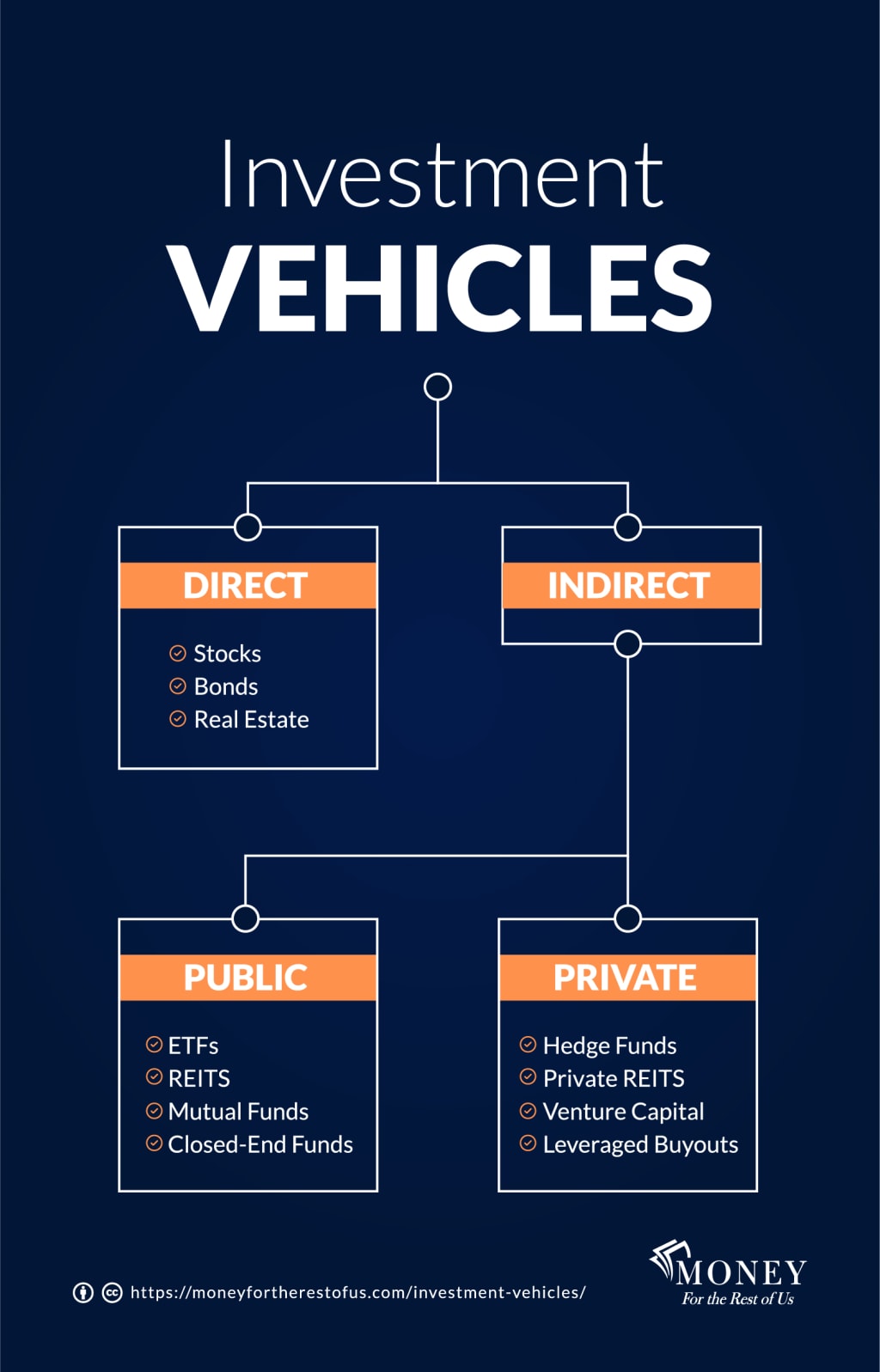Exploring different types of investment vehicles
stocks, bonds, mutual funds and ETFs

Introduction:
- Importance of investment instruments in wealth creation
- Understanding of different investment instruments
I. Shares: Ownership in companies:
- Definition and characteristics of shares
- How shares are traded on the stock market
- Advantages and disadvantages of investing in stocks
- The most important factors of investing in shares
- Types of shares: ordinary shares and preferred shares
II. Bonds: Fixed income:
- Definition and characteristics of covenants
- Types of bonds: government bonds, corporate bonds and municipal bonds
- How bonds work and generate income
- Advantages and disadvantages of investing in bonds
- Valuation of bond investments: credit ratings and yield
III. Mutual funds: Diversified portfolios:
- Understand investment funds and their structure
- Advantages of investing in mutual funds
- Types of investment funds: equity funds, bond funds, balanced funds, index funds and sector funds
- Valuation of mutual funds: expense ratio, historical performance and fund manager expertise
- The role of diversification in fund investments
IV. ETFs: Exchange Traded Funds:
- Definition and characteristics of ETFs
- How ETFs differ from mutual funds
- Advantages of investing in ETFs
- Types of ETFs: Stock ETF, Bond ETF, Sector ETF and Varva ETF
- Evaluating ETF Investments: Liquidity and Tracking Error
Conclusion:
- Importance of understanding different investment instruments
- Determine the right combination of investments based on individual goals and risk tolerance
- Seeking professional advice and thorough research before making an investment decision
Demonstration of investing:
Investing is an important part of financial planning that can help people grow their wealth and achieve their long-term goals. There are many investment instruments on the market, each with its own characteristics and advantages. In this article, we will look at the four main investment vehicles: stocks, bonds, mutual funds and ETFs, exploring their characteristics, advantages and considerations for potential investors.
I. Shares: Ownership in companies:
Shares represent ownership in a company. When individuals buy shares, they become shareholders and have the opportunity to participate in the growth and profitability of the company. Stocks are usually traded on exchanges such as the New York Stock Exchange (NYSE) or Nasdaq. Investors can buy and sell stocks through brokerage accounts.
Investing in stocks offers many benefits, including opportunities for capital appreciation, dividend income and ownership rights. But stocks also come with risks, such as market volatility and the possibility of capital loss. When investing in stocks, it is important to consider factors such as the financial condition of the company, industry trends and market conditions.
II. Bonds: Fixed income:
Bonds are debt instruments issued by governments, municipalities and companies to raise capital. When investors buy bonds, they lend money to the issuer in exchange for regular interest payments and the return of principal at maturity.
Bonds are known for their interest yield, which ensures predictable cash flow. Government bonds are generally considered less risky, while corporate bonds are higher. Investors can evaluate bond investments based on credit ratings, which indicate the creditworthiness of the issuer.
While bonds offer stability and income, their potential returns can be lower than stocks. When making investment decisions, bond investors should consider factors such as changes in interest rates, inflation and the financial strength of the issuer.
III. Mutual funds: diversified portfolios:
Mutual funds pool money from multiple investors to create a diversified portfolio managed by professional fund managers. These funds provide investors with access to a wide range of securities such as stocks, bonds and other assets. Mutual funds can be actively managed or passively managed (index funds).
Investing in mutual funds offers several advantages such as diversification, professional management and liquidity. Mutual funds serve different investment objectives and risk tolerances, offering investors options such as equity funds, bond funds, balanced funds and sector funds.
Investors should evaluate mutual funds based on factors such as expense ratio, historical performance and fund manager expertise. Diversification in a mutual fund helps reduce risk by spreading investments across multiple assets.
IV. ETFs: Exchange Traded Funds:
Exchange-traded funds (ETFs) are investment funds that are traded on the stock market, like stocks. ETFs offer investors exposure to a variety of asset classes, including stocks, bonds, commodities and sectors. ETFs differ from mutual funds in that they trade at market prices throughout the day. Investing in ETFs offers advantages such as diversification, low expense ratios, flexibility and intraday trading. There are different types of ETFs available, including stock, bond, sector and commodity ETFs. Investors should consider factors such as liquidity and tracking error when choosing an ETF.
Conclusion:
Understanding the different types of investment vehicles is critical for investors looking to maximize their wealth and achieve their financial goals. Stocks, bonds, mutual funds and ETFs offer distinct benefits and considerations that suit a wide range of investment goals and risk tolerance.
Before making investment decisions, it is important to do thorough research, assess individual goals and seek expert advice. By carefully evaluating the characteristics and performance of each investment vehicle, investors can create a comprehensive portfolio that meets their financial goals.
About the Creator
Reader insights
Outstanding
Excellent work. Looking forward to reading more!
Top insights
Compelling and original writing
Creative use of language & vocab
Easy to read and follow
Well-structured & engaging content
Expert insights and opinions
Arguments were carefully researched and presented
Eye opening
Niche topic & fresh perspectives
Masterful proofreading
Zero grammar & spelling mistakes
On-point and relevant
Writing reflected the title & theme






Comments
There are no comments for this story
Be the first to respond and start the conversation.